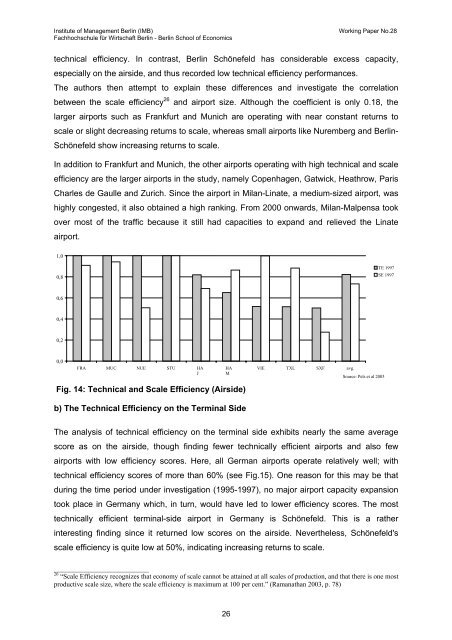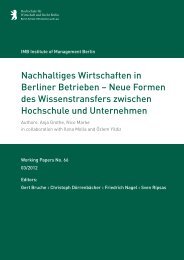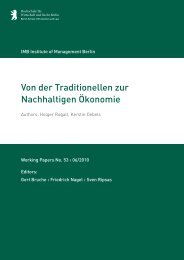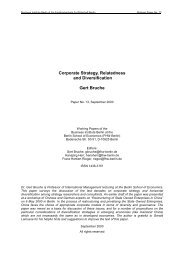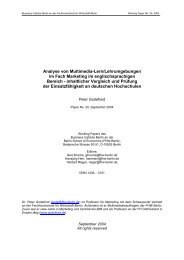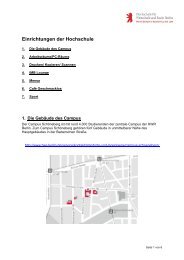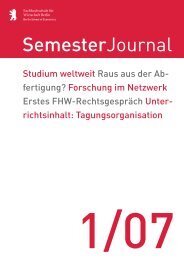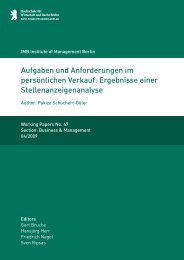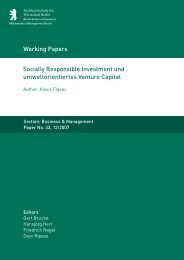Working paper template - MBA Programme der HWR Berlin
Working paper template - MBA Programme der HWR Berlin
Working paper template - MBA Programme der HWR Berlin
You also want an ePaper? Increase the reach of your titles
YUMPU automatically turns print PDFs into web optimized ePapers that Google loves.
Institute of Management <strong>Berlin</strong> (IMB) <strong>Working</strong> Paper No.28<br />
Fachhochschule für Wirtschaft <strong>Berlin</strong> - <strong>Berlin</strong> School of Economics<br />
technical efficiency. In contrast, <strong>Berlin</strong> Schönefeld has consi<strong>der</strong>able excess capacity,<br />
especially on the airside, and thus recorded low technical efficiency performances.<br />
The authors then attempt to explain these differences and investigate the correlation<br />
between the scale efficiency 26 and airport size. Although the coefficient is only 0.18, the<br />
larger airports such as Frankfurt and Munich are operating with near constant returns to<br />
scale or slight decreasing returns to scale, whereas small airports like Nuremberg and <strong>Berlin</strong>-<br />
Schönefeld show increasing returns to scale.<br />
In addition to Frankfurt and Munich, the other airports operating with high technical and scale<br />
efficiency are the larger airports in the study, namely Copenhagen, Gatwick, Heathrow, Paris<br />
Charles de Gaulle and Zurich. Since the airport in Milan-Linate, a medium-sized airport, was<br />
highly congested, it also obtained a high ranking. From 2000 onwards, Milan-Malpensa took<br />
over most of the traffic because it still had capacities to expand and relieved the Linate<br />
airport.<br />
1,0<br />
0,8<br />
0,6<br />
0,4<br />
0,2<br />
0,0<br />
FRA MUC NUE STU HA<br />
J<br />
Fig. 14: Technical and Scale Efficiency (Airside)<br />
b) The Technical Efficiency on the Terminal Side<br />
HA<br />
M<br />
VIE TXL SXF<br />
avg.<br />
Source: Pels et al 2003<br />
The analysis of technical efficiency on the terminal side exhibits nearly the same average<br />
score as on the airside, though finding fewer technically efficient airports and also few<br />
airports with low efficiency scores. Here, all German airports operate relatively well; with<br />
technical efficiency scores of more than 60% (see Fig.15). One reason for this may be that<br />
during the time period un<strong>der</strong> investigation (1995-1997), no major airport capacity expansion<br />
took place in Germany which, in turn, would have led to lower efficiency scores. The most<br />
technically efficient terminal-side airport in Germany is Schönefeld. This is a rather<br />
interesting finding since it returned low scores on the airside. Nevertheless, Schönefeld's<br />
scale efficiency is quite low at 50%, indicating increasing returns to scale.<br />
_________________________<br />
26 “Scale Efficiency recognizes that economy of scale cannot be attained at all scales of production, and that there is one most<br />
productive scale size, where the scale efficiency is maximum at 100 per cent.” (Ramanathan 2003, p. 78)<br />
26<br />
TE 1997<br />
SE 1997


